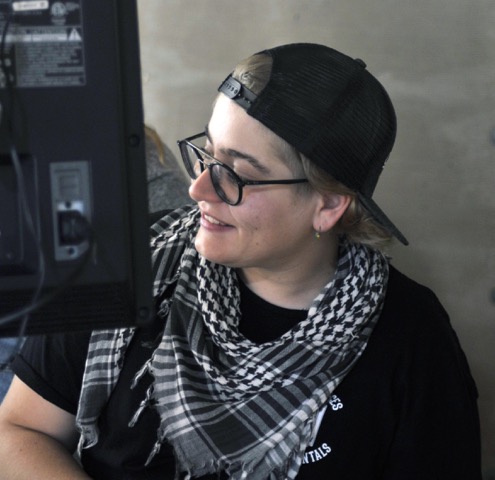A young woman walks along the street late at night by herself. Only moments ago she was surrounded by friends at a party and feeling secure; now she wonders if she was too confident about walking home alone. A stranger confronts her and she feels certain that her concerns are well founded. Women have been dealing with this scenario for as long as civilization has been in existence. It’s as relevant for the 12th century as for present day. In a textbook example of how certain filmmakers are ideally suited to tell specific stories, director/writer Lauren Henning and producer Maggie Jorgenson have paired together in the making of Text Me When You Get Home which presents the modern iteration of this truly female tale. To aid them in manifesting this, cinematographer Leo Sfeir has taken on the visual component of relating this frightening and all too common story. Relating how he came to the film, Sfeir states, “I got to talk to Lauren about the project and what she wanted for it. She and her producer [Maggie Jorgenson] were trying to create a crew that was as inclusive and have as many women and queer people as possible. I showed them some of my work and they got really excited by it and confirmed their choice after our first meeting.”

Text Me When You Get Home presents the complexity of sexual assault. Threats are layered and not always the most obvious ones. It’s a sad reality that women must be vigilant in discerning where danger resides. Every situation must be assessed on an individual basis; the lighting design is key in establishing this for the film. Leo’s design shifts from the warm naturalistic light of the party scene to contrasty, colder tones during Hunter’s (the ironically named main character) trek home, and finally the neutral grounding tones of her apartment. The DP describes, “For this movie I really wanted to get a relatively natural style of lighting to ground the viewer in the reality of the situation but be a little bit more contrasty and saturated in the park scene to give it an eerie feeling. I tried to accentuate the main kind of street light colors, sodium and mercury vape, giving it a duality in color with some orange and tile colors, getting cooler as the story moves forward. The film ends on a much more neutral color at Hunter’s place as her mind sinks in back into reality, trying to make sense of what just happened to her.” In what is perhaps the most frightening scene of Text Me When You Get Home or any film of this same subject matter, the camera takes a POV approach. The images and action is blurry and the screen intermittently goes dark and then returns to establish Hunter’s transitioning from unconsciousness to lucidity during the assault.
It was obvious based on the intense reaction of Text Me When You Get Homes’ festival run that the film’s impact was profound. For Leo Sfeir, this is parallel to the importance of using his skill as part of a team which delivers messages that are vital to the betterment of society as a whole. He relates, “Being able to create such an important story was very intense and rewarding. Working with two very talented women on such a subject and being able to create a film that puts you in the main character’s head to allow other people to understand how it feels was something that was both very hard and also very important. One of the things that really drives me as a cinematographer is being able to shine a light on difficult subjects that people have the tendency to keep quiet about. I truly believe that movies have the power to change people’s mind and potentially make the world a better place.”
https://www.instagram.com/textmewhenyougethomefilm/
Writer: Sharon Howe


Be the first to comment on "Manifesting Real World Terror with Cinematographer Leo Sfeir of Text Me When You Get Home"